HEBDEN BRIDGE: THE TOWN
HEBDEN BRIDGE is ‘a very special place. Some may think, in its aching trendiness, it’s away with the fairies. For others it’s somewhere over the rainbow.’ These intriguing words are from ‘brigger’ (i.e. raised in Hebden Bridge) Paul Barker’s book Hebden Bridge: a sense of belonging, published in 2012.
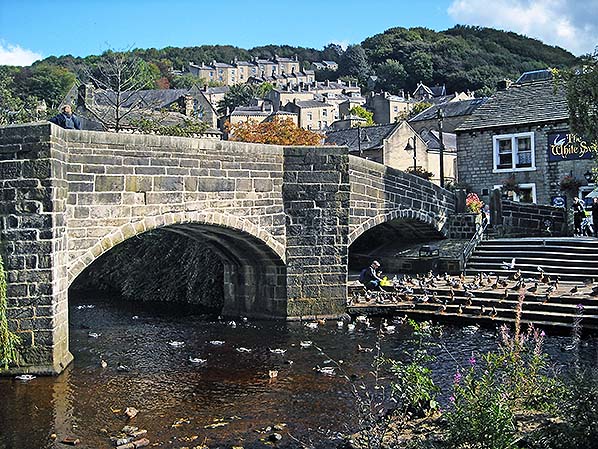 The packhorse bridge over Hebden Water from which the town derives its name was built c1510 and is a scheduled Ancient Monument. It replaced a timber structure. The bridge was on the track from Burnley and Heptonstall to Halifax, the main market for woollen cloth. Photo October 2016.
The packhorse bridge over Hebden Water from which the town derives its name was built c1510 and is a scheduled Ancient Monument. It replaced a timber structure. The bridge was on the track from Burnley and Heptonstall to Halifax, the main market for woollen cloth. Photo October 2016.
Photo
by Alan Young
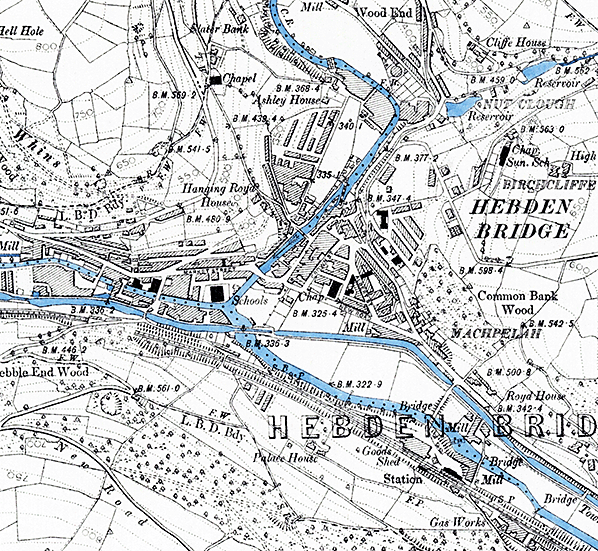 1894 1:2,500 OS map. Click here for a larger version.
1894 1:2,500 OS map. Click here for a larger version.
Until the 1980s this was a relatively obscure town; indeed the AA Road Book (1950) dismissed it as ‘on the river Calder and the Hebden Water’. The mills (unusually for Yorkshire) specialised in weaving cotton, particularly corduroy and fustian – a hard-wearing cloth made of cotton and wool - some of it turned into trousers in the town’s sewing shops. A 1921 official guide to the town described it as ‘the recognised centre in this country, if not the World, for the manufacture of fustian and corduroy cloths and garments’; more than 30 firms made corduroy ‘shipped to every part of the world’.
Until three centuries ago there was little but a bridge over Hebden Water and a corn mill, about five miles west of Halifax where the town is today. The weaving activity was found in moorland farms and hamlets, and in the village of Heptonstall about a mile outside Hebden Bridge. Woven cloth from Burnley, in Lancashire, and Heptonstall was carried by packhorses down the steep cobbled lane (The Buttress) and over the Hebden Bridge on its way to the market at Halifax.
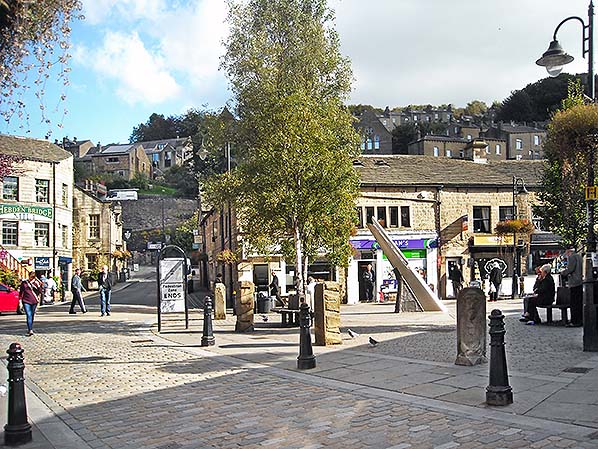 St George’s Square has some of the oldest buildings in Hebden Bridge, seen here in October 2016. The square was fully pedestrianised in 2007 to form a ‘piazza’, with the sundial based on a fustian knife (used in the local textile industry) as its highlight installed in 2008. It would have seemed an impossible dream half a century ago, but the town has been acclaimed as one of the few British towns to have something approaching a Mediterranean café culture!
St George’s Square has some of the oldest buildings in Hebden Bridge, seen here in October 2016. The square was fully pedestrianised in 2007 to form a ‘piazza’, with the sundial based on a fustian knife (used in the local textile industry) as its highlight installed in 2008. It would have seemed an impossible dream half a century ago, but the town has been acclaimed as one of the few British towns to have something approaching a Mediterranean café culture!
Photo
by Alan Young
The textile industry shifted from the moors into Hebden Bridge after the opening of a turnpike road (1740s) and the Rochdale Canal (1790s) followed by the Leeds & Manchester Railway (1840) on the valley floor. Textile mills at first used water power then switched to burning coal. From the 1870s workers who migrated into the town to operate the mills were housed in the distinctive ‘top and bottom’ (or ‘double-decker’) terraced houses which cling to the precipitous hillsides; the ‘top’ two-storey houses are entered from the upper side of the slope, and the ‘bottom’ ones, burrowing into the hillside, are entered from the opposite side. In addition to cotton mills Hebden Bridge was also home to Acre Mill, opened in 1939 to manufacture asbestos for gas masks. Sadly, many people first heard of the town in the early 1970s when former workers in the mill were suffering from asbestosis; Acre Mill was demolished in 1979.
In the 1960s, the town’s textile industry rapidly declined, as denim jeans made of imported cloth displaced corduroy trousers as work-wear and, as Barker (2012) writes, ‘a cloud of gloom started to settle’; in 1966 the local MP spoke of an ‘atmosphere of stagnation and decline’ and a letter in Hebden Bridge Times dismissed the town as ‘a dirty, scruffy hole’. The population fell, and many houses were left empty. However the town was discovered by ‘beatniks’, ‘hippies’ and art students who cheaply rented or squatted in the empty houses, and followers of New Age philosophies identified a strong spiritual magnetism in the town.
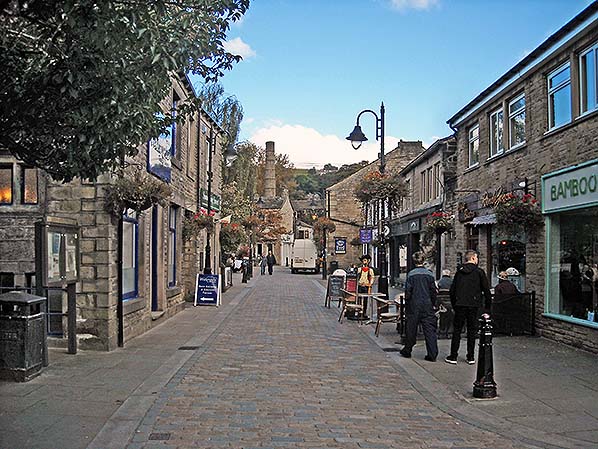 Bridge Gate in Hebden Bridge town centre is seen in 2016. The street was renovated and re-paved in 2007 as part of a pedestrianisation scheme.
Bridge Gate in Hebden Bridge town centre is seen in 2016. The street was renovated and re-paved in 2007 as part of a pedestrianisation scheme.
Photo
by Alan Young
Amidst the gloom, in 1965 the Calder Civic Trust was formed, originally to protect the environment of Hardcastle Crags, a picturesque wooded valley long popular with walkers, but the group turned its attention to promoting the wellbeing of Hebden Bridge. It was, ironically, to the town’s advantage that planners appointed to reshape the town took so long over it; Barker remarks that ‘doziness paid off’, so that while other centres such as Bradford were spoiled, Hebden Bridge suffered some demolition but the process did not advance very far. Thanks to the growing interest at that time in Victoriana and industrial archaeology, local pressure enabled the town centre to be designated a Conservation Area under the 1967 Civic Amenities Act. British Rail was dissuaded from demolishing and de-staffing the station, and it received Grade II listing. It is arguably the finest small town station on the national railway, and now has the most frequent services that it has ever known. The Pennine Way long distance footpath (designated in 1965) passes close to the town, whose facilities are sought out by walkers. Work began in the 1960s on returning the soot-blackened stonework of the town’s buildings to the pale cream colour that the Millstone Grit (sandstone) had when it was freshly quarried.
Thanks to the abandonment of plans to demolish many of its buildings Hebden Bridge can justifiably claim (along with Whitby, also in Yorkshire) to have one of Britain’s most authentic Victorian townscapes.
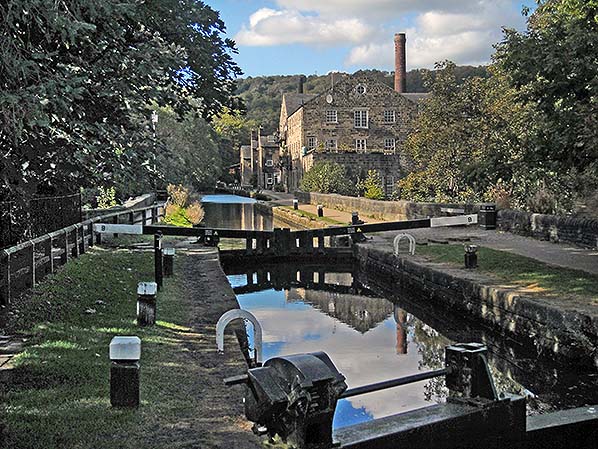 The Rochdale Canal, opened throughout in 1804, passes through Hebden Bridge. There are 91 locks, one of which is seen here. The canal contributed to the development of the town in the nineteenth century, enabling coal to be brought in from beyond Halifax. The former Calder Mill is seen beyond the lock. Photo October 2016
The Rochdale Canal, opened throughout in 1804, passes through Hebden Bridge. There are 91 locks, one of which is seen here. The canal contributed to the development of the town in the nineteenth century, enabling coal to be brought in from beyond Halifax. The former Calder Mill is seen beyond the lock. Photo October 2016
Photo
by Alan Young
Since the 1980s the town has been transformed into a remarkable place where a hybrid ‘community’ includes former mill workers, artists, actors and teachers, and residents can easily travel to work in Halifax, Burnley, Blackburn, Bradford, Leeds, Rochdale, Manchester and other centres. The Rochdale Canal, which fell out of use in 1951, has reopened for pleasure craft and its tow-path offers an enjoyable walk. A large new tourist information centre has been built beside the canal, its design so sensitively executed that many visitors must assume that it is Victorian. The town (with under 6,000 residents) boasts a cinema and a theatre, and in 2005 it was identified as having Britain’s ‘least cloned high street’; the town now celebrates itself as ‘best for independent shops’, and prides itself in having successfully resisted a leading chain store’s attempt to open a branch. Shops sell a bewildering range of goods. Recently, following partial pedestrianisation, cafés spread their tables and chairs across the pavements, and a coveted urban regeneration award has been received in recognition of this Yorkshire industrial town’s ‘Mediterranean’ atmosphere! Close to the centre are the attractive Memorial Gardens, laid out in 1938, and a large park (Calder Holmes) stretches between the town centre and the railway station.
Hebden Bridge was one of the first towns in Britain to commit itself to ‘Fair Trade’, and it is also a ‘Walkers are Welcome’ town. It was one of the first towns to set up a community website. A dubious accolade was conferred upon the town in 2005 when Highlife, British Airways’ in-flight magazine announced that Hebden Bridge was the fourth most ‘funky’ town in the world: ‘funky’ being loosely defined as ‘modern and stylish in an unconventional way’.
Unfortunately, the town occasionally makes headlines when the town centre is flooded as in the summer and autumn of 2012 and on Boxing Day 2015.
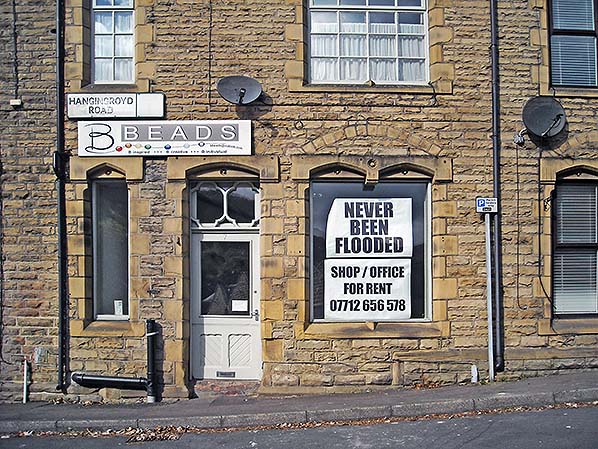 A bittersweet message is seen in the window of this empty property near the foot of Hangingroyd Road in October 2016, less than a year after the lower-lying parts of the town were inundated.
A bittersweet message is seen in the window of this empty property near the foot of Hangingroyd Road in October 2016, less than a year after the lower-lying parts of the town were inundated.
Photo
by Alan Young
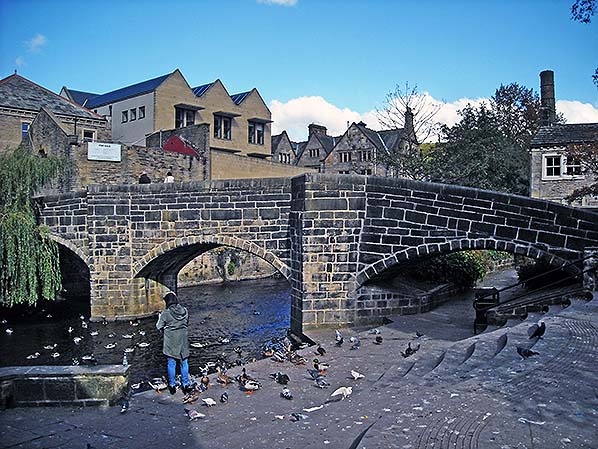
The packhorse bridge over Hebden Water from which the town derives its name was built c1510 and is a scheduled Ancient Monument. It replaced a timber structure. The bridge was on the track from Burnley and Heptonstall to Halifax, the main market for woollen cloth. Photo October 2016.
Photo
by Alan Young
Market Street in Hebden Bridge, the main A646 road between Burnley and Halifax, is seen in October 2016. The street has a fascinating collection of specialist shops, including ‘2 Tone Comics’ and ‘Muse’ music café (foreground), art, books and organic foods.
Photo
by Alan Young
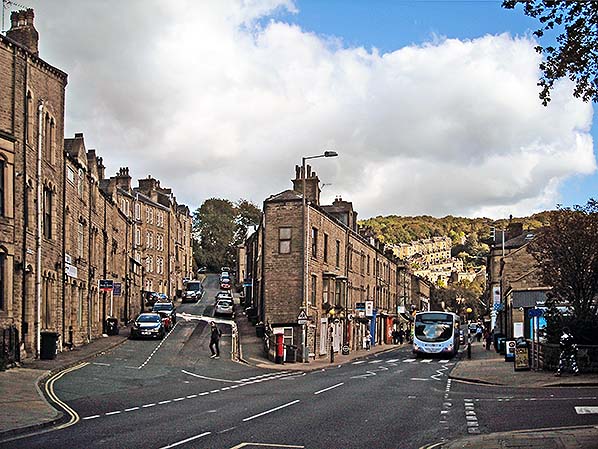
Market Street and (left) Hangingroyd Road in Hebden Bridge, seen in October 2016.
Photo by Alan Young.
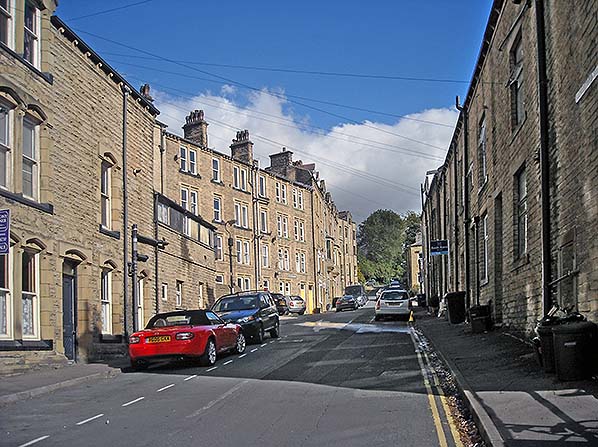
Hangingroyd Road, Hebden Bridge in October 2016. The tall buildings ahead are the ‘double-decker’ or ‘top-and-bottom’ houses characteristic of the town. The two lower storeys are entered through the doors on this street, while the upper storeys look like ‘conventional’ terraced houses when entered from a higher street on the opposite side: an enterprising way of building on the very steep slopes of the Calder valley. Such houses were seen as ripe for demolition 50 years ago, but they are now considered highly desirable properties.
Photo
by Alan Young
Click here for Hebden Bridge Station


 The packhorse bridge over Hebden Water from which the town derives its name was built c1510 and is a scheduled Ancient Monument. It replaced a timber structure. The bridge was on the track from Burnley and Heptonstall to Halifax, the main market for woollen cloth. Photo October 2016.
The packhorse bridge over Hebden Water from which the town derives its name was built c1510 and is a scheduled Ancient Monument. It replaced a timber structure. The bridge was on the track from Burnley and Heptonstall to Halifax, the main market for woollen cloth. Photo October 2016. 1894 1:2,500 OS map. Click
1894 1:2,500 OS map. Click  St George’s Square has some of the oldest buildings in Hebden Bridge, seen here in October 2016. The square was fully pedestrianised in 2007 to form a ‘piazza’, with the sundial based on a fustian knife (used in the local textile industry) as its highlight installed in 2008. It would have seemed an impossible dream half a century ago, but the town has been acclaimed as one of the few British towns to have something approaching a Mediterranean café culture!
St George’s Square has some of the oldest buildings in Hebden Bridge, seen here in October 2016. The square was fully pedestrianised in 2007 to form a ‘piazza’, with the sundial based on a fustian knife (used in the local textile industry) as its highlight installed in 2008. It would have seemed an impossible dream half a century ago, but the town has been acclaimed as one of the few British towns to have something approaching a Mediterranean café culture! Bridge Gate in Hebden Bridge town centre is seen in 2016. The street was renovated and re-paved in 2007 as part of a pedestrianisation scheme.
Bridge Gate in Hebden Bridge town centre is seen in 2016. The street was renovated and re-paved in 2007 as part of a pedestrianisation scheme. The Rochdale Canal, opened throughout in 1804, passes through Hebden Bridge. There are 91 locks, one of which is seen here. The canal contributed to the development of the town in the nineteenth century, enabling coal to be brought in from beyond Halifax. The former Calder Mill is seen beyond the lock. Photo October 2016
The Rochdale Canal, opened throughout in 1804, passes through Hebden Bridge. There are 91 locks, one of which is seen here. The canal contributed to the development of the town in the nineteenth century, enabling coal to be brought in from beyond Halifax. The former Calder Mill is seen beyond the lock. Photo October 2016 A bittersweet message is seen in the window of this empty property near the foot of Hangingroyd Road in October 2016, less than a year after the lower-lying parts of the town were inundated.
A bittersweet message is seen in the window of this empty property near the foot of Hangingroyd Road in October 2016, less than a year after the lower-lying parts of the town were inundated.
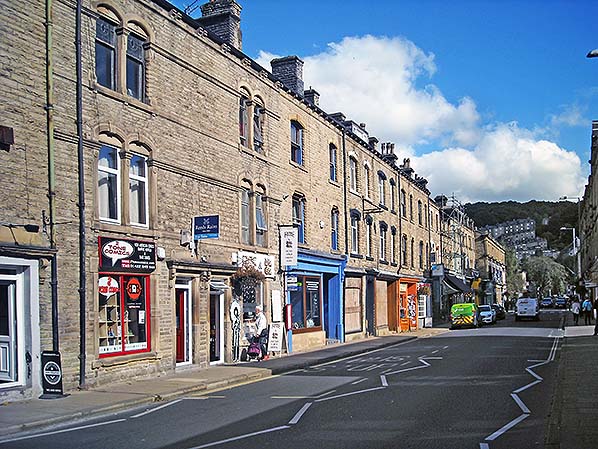


 Home Page
Home Page